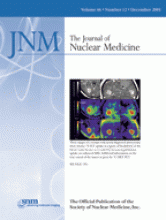Abstract
Angina pectoris is a major symptom associated with myocardial ischemia. The aim of this study was to find whether stress myocardial perfusion imaging can independently predict mortality in patients with angina. Methods: We studied 455 patients with stable angina pectoris by exercise or dobutamine stress 99mTc-tetrofosmin myocardial perfusion tomographic imaging. An abnormal finding was defined as a reversible or fixed perfusion abnormality. The endpoint during follow-up was death from any cause. Results: Mean age was 60 ± 10 y. There were 266 men (58% of the patients). Myocardial perfusion was normal in 137 patients (30%). Perfusion abnormalities were reversible in 167 patients and fixed in 151 patients. During a mean follow-up of 6 ± 1.7 y, 93 patients (20%) died. The annual mortality rate was 1.5% in patients with normal perfusion and 4.5% in patients with abnormal perfusion. Patients with a multivessel distribution of perfusion abnormalities had a higher annual death rate than patients with abnormalities in a single-vessel distribution (5.1% vs. 3.7%). In a multivariate analysis model, independent predictors of death were age (risk ratio, 1.05; 95% confidence interval [CI], 1.03–1.08), the male sex (risk ratio, 2.1; CI, 1.3–3.4), diabetes (risk ratio, 2.2; CI, 1.4–3.5), heart failure (risk ratio, 2.7; CI, 1.6–4.5), smoking (risk ratio, 1.7; CI, 1.1–2.6), reversible perfusion abnormalities (risk ratio, 1.9; CI, 1.1–2.8), and fixed perfusion abnormalities (risk ratio, 2; CI, 1.2–3.1). Conclusion: Stress 99mTc-tetrofosmin myocardial perfusion imaging provides independent information for predicting mortality in patients with stable angina pectoris. Both reversible and fixed defects are associated with an increased risk of death. The extent of stress perfusion abnormalities is a major determinant of mortality. Patients with normal perfusion have a low mortality rate during long-term follow-up.
Footnotes
Received Jul. 18, 2005; revision accepted Sep. 6, 2005.
For correspondence or reprints contact: Abdou Elhendy, MD, PhD, 982265 Nebraska Medical Center, Omaha, NE 68198-2265.
E-mail: Aelhendy{at}unmc.edu







